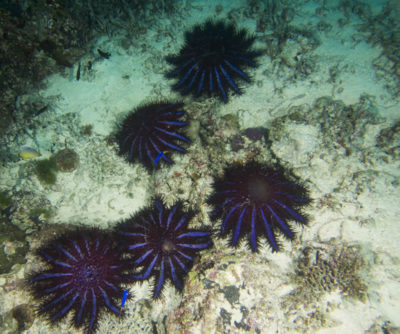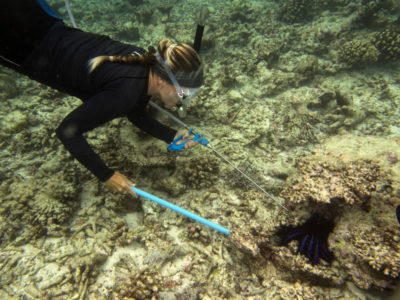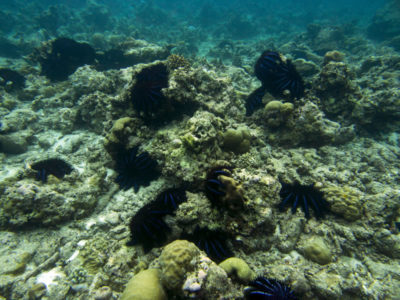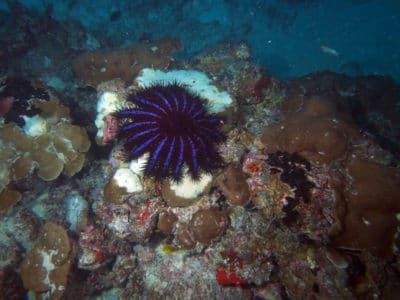Expedition Log: Maldives – Day 10
Crown of thorns starfish (COTS) are novel among the animal kingdom for many reasons. They can shed an appendage, or even lose more than half their body and survive by quickly re-growing the injured or damaged body parts. They can go months without food while seeking a new reef. They can detect pheromones from other starfish and smell coral. They move quickly and can firmly attach to the seabed using suckers that occur on the end of the thousands of tube feet that line the grooves extending under each of their arms. They move hydraulically using fluid within their body cavities. And most importantly, they systematically eat virtually every coral on a reef, in a synchronous wave, and then migrate to the next reef to continue destroying reef systems for years to decades.

Starfish moving across the sand.
These and other features often lead me to question whether there is any hope for the defenseless coral. Especially in places like Reethi Rah, at the epicenter of the outbreak and the proposed origin of the outbreak. Reethi Rah, at the western end of North Malé Atoll has been historically affected most severely by COTS. There is one previous documented outbreak in the Maldives. It started in 1988, in the vicinity of Reethi Rah, and followed a similar pattern of spread with subsequent outbreaks appearing over the next 3-4 years on other atolls. After high levels of destruction, the starfish disappeared, and reefs slowly rebounded.

Injecting COTS with bile salts.
But they are back, emerging on this reef system in May 2013, and slowly advancing across the reef system eliminating corals from entire patch reefs and fore reef communities before moving to new areas. Recognizing the losses that occurred in the late 1980s, marine biologists and dive centers at neighboring resorts were the first to respond. Our discussions with fishermen, biologists and resort staff suggest that tens of thousands of starfish were either removed, or injected over the preceding two years. Yet this effort was inadequate to save many of the Maldives’ reefs. Some of the flourishing house reefs, wrecks and other sites frequented by the dive centers are now devoid of coral, and the plague of starfish continues to threaten the viability of the remaining reefs.
As we planned our system of attack in Reethi Rah, we expected to find numbers of COTS that exceeded what we had collected at Gili Lankanfushi. But what we did not expect to find was the unique distribution and movement patterns of the starfish.
The initial effort was focused on a linear reef system in the lagoon at Westpoint. The starfish had invaded this reef from its western end, near the outside of the lagoon, and were advancing to the east, denuding the reef of its coral in a defined band that extended from 2 m depth to the base of the reef at 30 m. We swam with the current, first crossing over sections of reef that had been eaten in weeks past, finding isolated starfish. As we neared the outbreak, more white lesions became apparent, and numbers of starfish increased. The COTS had found an enormous patch of large table acroporids, and in some cases dozens of starfish covered the tops and undersides of these corals. They also fed on many other corals, but mostly fast growing branching species; they tended to avoid the massive boulder corals. Over two days, we eliminated most of the starfish from the reef. We found the starfish concentrated in aggregations that covered 10-100 m of reef. In some cases we removed more than 300 animals from a 5 square meter patch! The starfish were aggregated together and often piled on top of each other. After multiple long dives, we reached the end of the outbreak, encountering a beautiful section of sloping reef habitat with flourishing branching and table acroporids, massive and plating corals and many other species, without any signs of mortality and no evidence of COTS.
We then moved to a second patch reef, relatively close by, that had displayed a similar pattern of destruction. The main difference was that the starfish appear to have invaded this reef weeks earlier, as there was a much more extensive area of old dead coral and the COTS were spread throughout the reef system. Fortunately, we were able to remove the majority of the starfish from this reef.
What was most unusual was what we saw near the resort. The house reef facing into the lagoon had been badly damaged by COTS and local staff had removed or killed thousands of animals here. Other lagoonal reefs on the back side of the island, as well as the adjacent fore reef on the western end and lagoonal reefs surrounding a neighboring island had very little remaining live coral cover. In one area the only corals left were massive boulder corals (Porites) and nearly every one of these had a recent lesion from COTS predation. Over a two day period we collected over 400 animals in this area, but most were not on coral. The remaining COTS were searching for food. They were moving across the sand rubble, and could be found coming up onto the beach and on the pilings and steps of the water villas. We also found COTS within the marina on large boulders.
This pattern of movement had been noted for months, as two lifeguards were assigned to patrol the beaches and remove starfish. Using a small dingy, they slowly circumnavigated the nearshore sandy areas searching for COTS. They each had a long wooden stick with two stainless steel spears to impale and remove the starfish. Each day they collected up to 100 animals.
As we wrapped up our work in Reethi Rah, we felt a sense of accomplishment having removed all the COTS from two reefs. At the same time we were apprehensive about our success. Neighboring resorts had identified a half dozen other patch reefs that had similar numbers of COTS to the two we cleaned up. Critical coral resources had already been lost and the plague here was not under control. There was however, a sense of ownership and responsibility expressed by each of the dive centers and marine biologists, and ongoing coordination among the different resorts to clean up the remaining reef systems. Reethi Rah was also probably best equipped out of all locations we visited as they had invested in injection systems and had purchased bile salts, which currently are recognized as the most practical, non-destructive and effective chemical to kill COTS.
Photos by Andrew Bruckner



